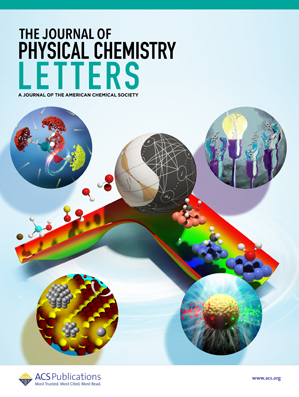Cavity-Mediated Collective Resonant Suppression of Local Molecular Vibrations
IF 4.8
2区 化学
Q2 CHEMISTRY, PHYSICAL
引用次数: 0
Abstract
Recent advances in polaritonic chemistry suggest that chemical reactions can be controlled via collective vibrational strong coupling (VSC) in a cavity. In this fully analytical work, we demonstrate that the collective vibrations of a molecular ensemble under VSC execute a beating with a period inversely proportional to the collective vacuum Rabi splitting. Significantly, this collective beating is imprinted on the local dynamics and resonantly suppresses individual molecular vibrations when a fraction of molecules is vibrationally excited, as in activated complexes formed in chemical reactions. This emergent beating occurs on significantly longer time scales than the individual molecular vibration or the cavity field oscillation period, peaking at the cavity-molecule resonance, consistent with polaritonic chemistry experiments. The cavity mediates an energy exchange between excited and ground-state molecules, affecting the dynamics of the entire ensemble. These findings suggest that the dynamics in polaritonic chemical reactions may not be in full equilibrium. In the ultrastrong coupling regime, we find that the local vibrations are modified by the cavity even at short time scales. Notably, these dynamical effects also extend to isotropic molecular ensembles in our model. Our analytical model offers insights into how collective VSC can dampen local molecular vibrations at resonance, potentially altering chemical reactivity.局部分子振动的腔介导集体共振抑制
极化化学的最新进展表明,化学反应可以通过腔内的集体振动强耦合(VSC)来控制。在这项全面的分析工作中,我们证明了分子系综在VSC下的集体振动执行周期与集体真空拉比分裂成反比的跳动。值得注意的是,当一部分分子被振动激发时,就像在化学反应中形成的活化复合物中一样,这种集体的振动会被印在局部动力学上,并共振地抑制单个分子的振动。与单个分子振动或腔场振荡周期相比,这种突发性跳动发生的时间尺度明显更长,在腔-分子共振处达到峰值,与极化化学实验一致。空腔介导激发态和基态分子之间的能量交换,影响整个系综的动力学。这些发现表明,极化化学反应的动力学可能不是完全平衡的。在超强耦合状态下,我们发现即使在短时间尺度上,局部振动也会被腔所改变。值得注意的是,在我们的模型中,这些动力学效应也延伸到各向同性分子系。我们的分析模型提供了关于集体VSC如何在共振时抑制局部分子振动,从而潜在地改变化学反应性的见解。
本文章由计算机程序翻译,如有差异,请以英文原文为准。
求助全文
约1分钟内获得全文
求助全文
来源期刊

The Journal of Physical Chemistry Letters
CHEMISTRY, PHYSICAL-NANOSCIENCE & NANOTECHNOLOGY
CiteScore
9.60
自引率
7.00%
发文量
1519
审稿时长
1.6 months
期刊介绍:
The Journal of Physical Chemistry (JPC) Letters is devoted to reporting new and original experimental and theoretical basic research of interest to physical chemists, biophysical chemists, chemical physicists, physicists, material scientists, and engineers. An important criterion for acceptance is that the paper reports a significant scientific advance and/or physical insight such that rapid publication is essential. Two issues of JPC Letters are published each month.
 求助内容:
求助内容: 应助结果提醒方式:
应助结果提醒方式:


